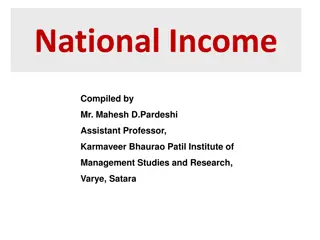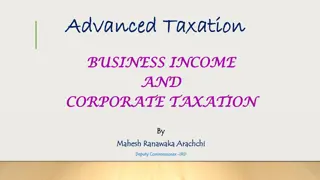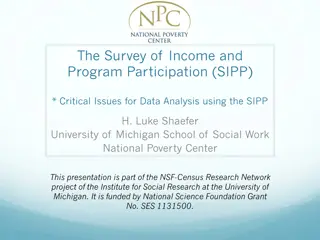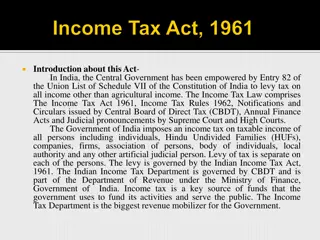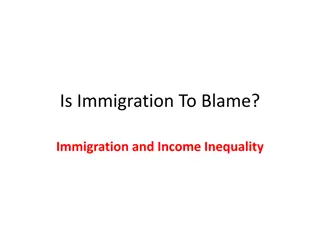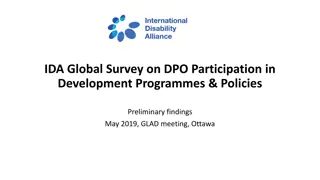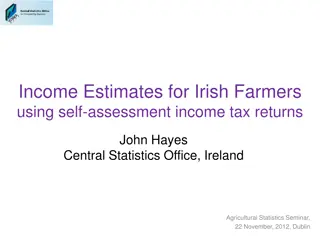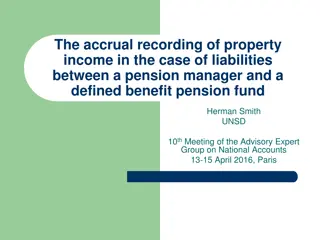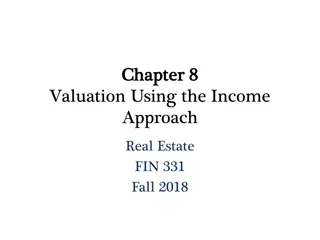Introduction to the Survey of Income and Program Participation (SIPP)
The Survey of Income and Program Participation (SIPP) is a nationally representative, longitudinal survey providing data on income dynamics, government program participation, and social contexts of U.S. households. The SIPP aims to evaluate annual and sub-annual changes in income, program participation, and family structure. Designed as an improvement over the Current Population Survey (CPS), the SIPP offers more accurate and detailed data essential for understanding poverty and social welfare programs.
Download Presentation

Please find below an Image/Link to download the presentation.
The content on the website is provided AS IS for your information and personal use only. It may not be sold, licensed, or shared on other websites without obtaining consent from the author. Download presentation by click this link. If you encounter any issues during the download, it is possible that the publisher has removed the file from their server.
E N D
Presentation Transcript
Introduction to The Survey of Income and Program Participation (SIPP) H. Luke Shaefer University of Michigan School of Social Work National Poverty Center This presentation is part of the NSF-Census Research Network project of the Institute for Social Research at the University of Michigan. It is funded by National Science Foundation Grant No. SES 1131500.
Goals for the 2014 SIPP Workshop Provide you with an introduction to the SIPP and get you up and running on the public-use SIPP files Offer some advanced tools for SIPP data analysis Get you some experience analyzing SIPP data Give you some quiet time to work on your own SIPP project Help you push forward on that project Get you to beautiful Ann Arbor (which is lovely in the summertime)
H. Luke Shaefer Associate professor of social work, research affiliate at the National Poverty Center, and one of many co-investigator of the University of Michigan-ISR Census Node Interested in how public programs serve low-income families with children Began working with the SIPP for my dissertation Still trying to recoup the fixed costs Have worked with public-use files, restricted data, and synthetic data Roughly half my published papers use the SIPP Proud father of 5-year-old Bridget and 1-year-old Michael
Tell Us About Yourself What s your field? Where are you at now? What attracted you to the workshop? What kind of research are you hoping to conduct with the SIPP?
The SIPP Nationally representative, longitudinal, multi-stage stratified sample Continuous data in 2.5 to 4-year panels from the 1980s through present Sample: Civilian, non-institutionalized U.S. households The SIPP s mission: to provide a nationally representative sample for: evaluating annual and sub- annual dynamics of income, movements into and out of government transfer programs, the family and social context of individuals and households, and interactions between these items.
The SIPP Originally designed to compensate for the limitations of the Current Population Survey (CPS) CPS ASEC (March Supplement) uses a very long recall period Not good at measuring irregular/ odd sources of income High levels of under-reporting of program participation Doesn t capture changes in family structure over time Note: If this makes you panic about the accuracy of our official poverty/insurance estimates from CPS, no-one will blame you SIPP was designed to provide month-level detail and have a (much) shorter recall period SIPP is meant to provide better estimates of income and public program participation Offers the most detailed income and comprehensive program participation variables of the major nationally representative household surveys
Whats included in the SIPP? The core monthly files include: Demographics: race & ethnicity, age, sex, household/family structure & relationships, state identifiers, education, marital status, student status Income: Person/family/household earned income, total income, property income, other income unit-specific poverty thresholds, receipt of severance pay Employment: Employed, unemployment, not in the labor force, Data on up to 2 jobs/month, industry, occupation, class of worker (public/private), firm size, union membership, tenure, hourly/salaried, employer-based health insurance
Whats included in the SIPP? The core monthly files include: Program participation: Unemployment Insurance, AFDC/TANF , social security, SSI, SSD, workers comp, child support, food stamps (SNAP), public housing assistance, energy assistance, public (and private) health insurance, free/reduced lunch, veterans payments, pell grants receipt, other federal grant program receipt Most program participation variables include both receipt (0,1) and the amount of benefit THIS IS NOT A COMPREHENSIVE LIST! http://www.census.gov/programs-surveys/sipp/tech- documentation/data-dictionaries/data-dictionaries-2008.html
Whats included in the SIPP? Topical Modules: Extra questions added to the core once per year/panel in particular waves. These include point-in-time/annualized variables on things such as: Fertility history Migration history Material hardship measures (such as food security) Assets and liabilities Medical expenses/utilization of health care Work schedule Note: A major change with the 2014 SIPP redesign will be to incorporate TM content into the core interview Most content areas have been retained, though some at reduced levels of detail Some areas will have expanded detail THIS IS NOT A COMPREHENSIVE LIST! http://www.census.gov/programs-surveys/sipp/tech-documentation/topical- modules.html
SIPP Panels: Dates and Sample Size Panel Dates Wave 1, ref 4 Household Heads 1976-1979 Income Survey Development Program panel: Data are not readily available, but you may be able to get them 1984-1989 panels: harder to access, different file structure still, they are available and valuable 1990 1989-1992 1991 1990-1993 1992 1991-1995 1993 1992-1995 1996 1996-2000 2001 2001-2003 2004 2004-2007 2008 2008-2013 Wave 1, ref 4 n 21,800 14,200 19,500 19,796 36,730 35,100 43,500 42,000 58,100 37,400 51,200 52,000 95,300 90,200 110,700 105,600 Major changes start with the 1996 panel, so this weekend we will use that and the more recent panels
Sample Selection & Data Editing Nationally representative of the US non-institutional population Institutionalized individuals (e.g. those in prison or nursing homes) are not included Also designed to provide reliable estimates at the state level Households from areas with high poverty concentrations are oversampled Primary wave 1 data collection unit is the household, not the individual Multi-stage stratified sample design: 1) Selection of primary sampling units (PSUs) from strata of similar areas 2) Selection of address units within PSUs
Sample Selection & Data Editing The sampling frame is a list of US counties and independent cities, based on the most recent Decennial Census Addresses in frames are clustered into Primary Sampling Units or PSUs (usually counties or collections of counties) PSUs are organized into strata that are similar based on a series of characteristics PSUs are then selected from each strata Then, addresses are selected from within the selected PSUs
Sample Selection & Data Editing Data Editing When one person in a household is missing for an interview and a proxy interview cannot be collected Or when particular items are missing for various reasons: Public use data are imputed Imputation is a sequential hot-deck procedure: missing data are matched with a donor who has similar characteristics (The Redesigned SIPP will have new imputation procedures) Income variables are top-coded to protect respondents and edited for logical consistency
Using the Full Panel (Attrition) All adult original sample persons (OSP) are followed for the duration of the panel, unless they leave the sample universe Attrition is a problem, and is non-random. This matters for those of us that study vulnerable populations If an adult (15+) OSP moves to another address, they are followed there, and everyone they live with there is followed as long as they live with the original sample person When an entire household is missing at a wave interview, they are dropped for the wave (but could reappear later) Full panel sample: Original sample followed for the duration must use panel weights for such analyses
File Structure: Public Use Files These bullets pertain to the 2008 and prior panels, and will not be accurate for the new SIPP EHC discussed later in this presentation Each panel consists of an independent sample that is followed for 2.5 to 4 years Core data are collected every 4 months during waves, reporting on the previous 4 months Not surprising that reporting months are most accurate There are 4 randomly selected rotation groups in each wave Census staggers the start of each rotation group by month
File Structure (<=2008 Panels) Reference Month 12/95 1/96 2/96 3/96 4/96 5/96 6/96 7/96 8/96 9/96 10/96 Rot Grp 1 Rot Grp 2 Rot Grp 3 Rot Grp 4 W1 Ref1 W1 Ref2 W1 Ref3 W1 Ref4 W2 Ref1 W2 Ref2 W2 Ref3 W2 Ref4 W3 Ref1 W3 Ref2 W3 Ref3 W1 Ref1 W1 Ref2 W1 Ref3 W1 Ref4 W2 Ref1 W2 Ref2 W2 Ref3 W2 Ref4 W3 Ref1 W3 Ref2 W1 Ref1 W1 Ref2 W1 Ref3 W1 Ref4 W2 Ref1 W2 Ref2 W2 Ref3 W2 Ref4 W3 Ref1 W1 Ref1 W1 Ref2 W1 Ref3 W1 Ref4 W2 Ref1 W2 Ref2 W2 Ref3 W2 Ref4
File Structure Core file wave data are organized into person-month observations Each person will have a record for each month they appear in the wave so up to 4 observations, per person, per wave Household/family/subfamily variables are duplicated in each person s monthly record So each household member record contains the household/family/subfamily variables, leading to lots of duplication This can cause confusion (at least for me ) Example: RFOKLT18-- Number of own children under 18 in family
Some Definitions Households: a group of persons who occupy a housing unit Includes: Families, a group of friends sharing a house, two unrelated families, co-housed, an unmarried mother and boyfriend Does not include group quarters: boarding houses, college dorms, monasteries Family: 2+ people related by birth, marriage, or adoption who reside together See any potential problems here, given family complexity? Related subfamily: A nuclear family related to but not including the household reference person Unrelated subfamily: A nuclear family that is not related to the household ref person
Topical Modules Come in separate files Can merge topical module content into the core using person/household identifier, wave, and reference month variables 1996-2008: Topical modules usually attach to the final (4th) reference month of the current wave There is a lot of variation with the different topical modules in terms of reference period and known quality of the data Comprehensive list available here: http://www.census.gov/programs-surveys/sipp/tech- documentation/topical-modules.html
The SIPP Synthetic Beta and Restricted data In the Census RDC (undisc. location on a number of campuses across the country), with special sworn status, it is possible link SIPP with SSA & IRS, and other admin data Can get SIPP data connected to things like lifetime earnings, SSA benefit recipiency It is a priority for Census to make these data available to the public while also protecting the privacy of respondents Thus they have created the SIPP Synthetic Beta (SSB) http://www.census.gov/programs- surveys/sipp/methodology/sipp-synthetic-beta-data- product.html Synthesized data based on real micro-data that should reproduce the characteristics of the underlying confidential micro-data outside of the RDC This is in a testing phase: Census will duplicate SSB results on confidential data and share approved output
The SIPP Redesign Because of concerns about respondent burden, cost, and the complexity of the data, the Census Bureau has just recently redesigned the SIPP The NEW SIPP uses an annual recall, but with an event history calendar (EHC) First wave is in the field now, reporting on calendar year 2013 A National Research Council Panel will compare the 2008 panel estimates from 2013 to the new redesigned SIPP EHC pilot data are proving to compare well in some regards to the 2008 estimates There is overlap between the 2008 SIPP panel and the new SIPP EHC in 2013, which will allow for comparisons Still lots of time to use the 2008 panel, which was fielded through much of 2013!
What is the SIPP Good For? Can use SIPP as a stacked sample of repeated cross sections Can generate monthly national/state-level estimates Can generate annualized estimates Results appear most accurate for the current month of reporting month (reference month 4) in each wave This issue is commonly referred to as seam bias Estimates must be adjusted for sample design The SIPP s most powerful use is for longitudinal analysis (that s what will warm my heart to see you do)
What Isnt It Good For? Studying the top of the income distribution Long longitudinal analyses (over a life course, say, use PSID) If you need annual estimates for every year If you don t want to deal with the complexities in household/family composition that the SIPP uncovers
Use the SIPP When You want to deal with more of the complexity of messy questions You want the best available survey-based estimates of the income of the poor You want to benefit from overall higher reporting rates for public program participation You want to conduct longitudinal analyses over relatively short periods (month-to-month; annualized; up to 4 years)
The Uninsured in America, 2005 Non-Elderly (Estimates by ERIU) Dataset During the year N/A All year Point-in-time CPS 44.4 million 17.2% 27.6 million 10.7% 36.5 million 14.0% N/A SIPP 65.9 million 25.6% 66.9 million 25.7% 45.2 million 17.6% 50.1 million 19.2% MEPS
Health Insurance & Divorce Lavelle, B. & Smock, P .J. (2012). Divorce and Women s Risk of Health Insurance Loss. Journal of Health and Social Behavior, 53(4), 413-431.
Workshop Resources Data files for 1996 through 2008 available core public use files (in stata) Data files for some key topical modules Version of the current user guide with updated chapters merged in (page numbers will be off) http://www.census.gov/programs- surveys/sipp/methodology/users-guide.html Some useful technical papers on the SIPP Exercises we ll be doing this week



